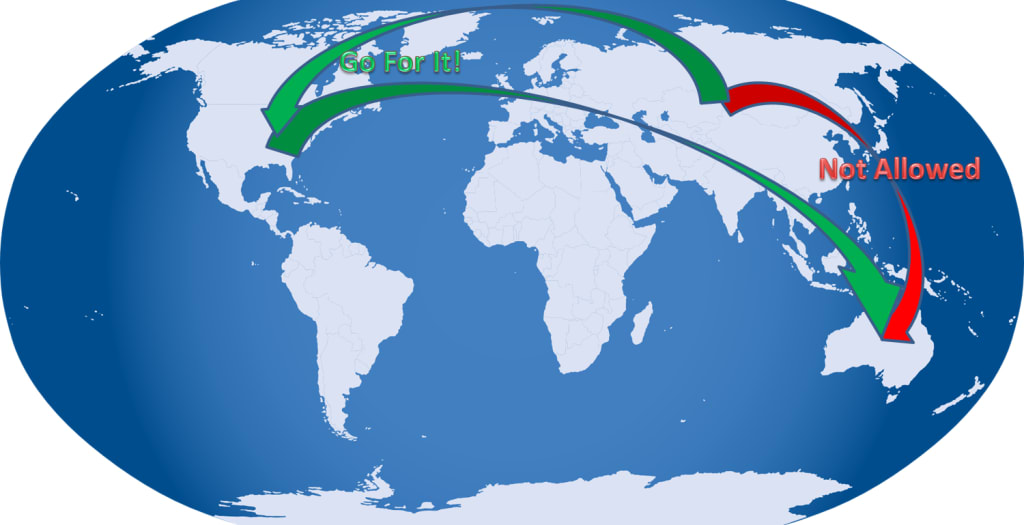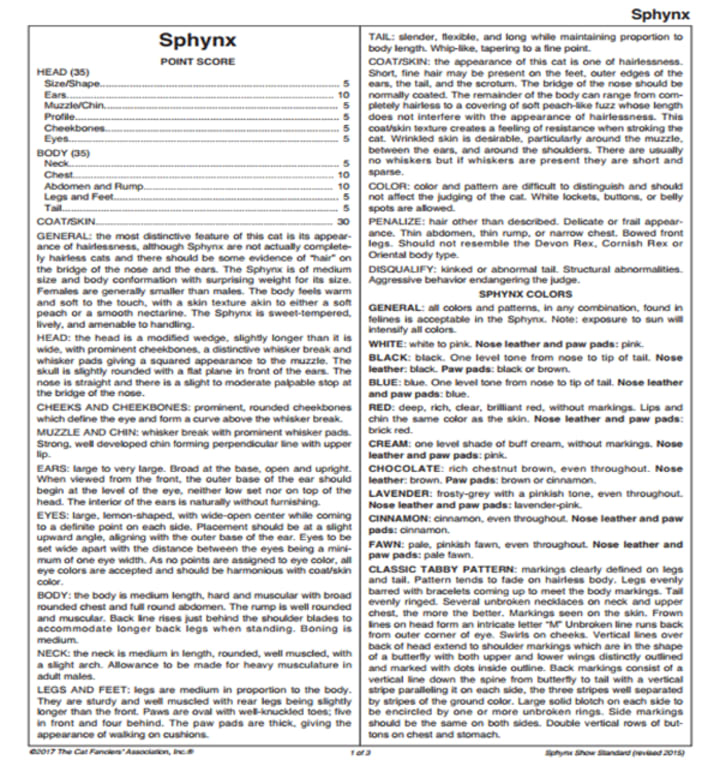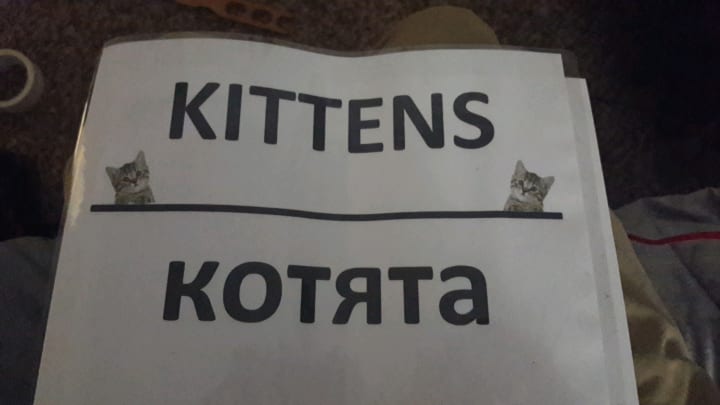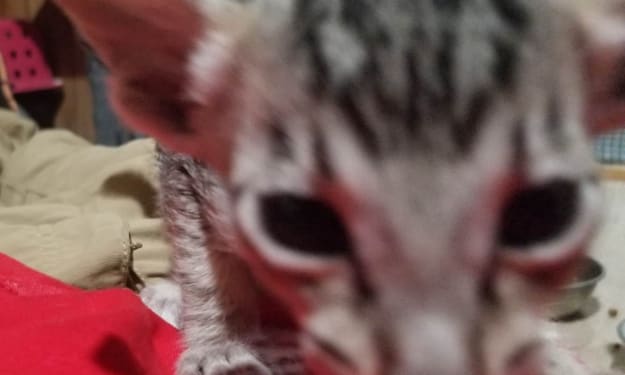
It turns out that if you live in Australia and want to purchase a cat from the Country of Russia you can not do so directly. For a variety of reasons, some legitimate, some political, it is impossible to import domestic animals directly into Australia from Russia without a stopover in a different country from which such transactions are allowed. Surprisingly it is possible to send animals, domestic cats at least, directly from the United States to Russia. All of the facts in the above introduction were completely unknown to me until approximately three weeks ago when a good friend of mine asked if I would be willing to help her transfer two kittens from Russia to Australia.
My friend as it turns out owns a cattery business, which, in case you were unaware, is an establishment for boarding and/or breeding cats. She is mostly a breeder but does some boarding on occasions such as this transfer situation if the money or other compensations are worth it. Unlike most other business transactions, money (at least of the immediate direct payment variety) is not the primary motivator of deals such as this one.
In this particular instance the arrangement was made because of a long-standing friendship with a fellow breeder in Australia and a desire for access to cost effective transportation of another cat to her from a particular cattery in Germany that does not ship internationally. Access to this gene pool would allow her to improve the confirmation and overall type of her own cats and thus greatly increase their chances of winning shows and intrinsic future value as breeding stock. Essentially she was trading the work necessary to get the cats from Russia to Australia for the means for one or more of her cats to screw or get screwed by one or more other cat(s). And so the circle of life is complete.
The money that can be made in this business is not trivial. Top of the line, rare, genetically desirable cats can sell for many thousands of dollars or more depending on the breed, bloodline and color. Competing in shows increases the value of any given cat and the cat’s my friend deals with are or will be titled show cats before they are ever bred. Surprisingly, or perhaps not, show prize money is low and most of the money is made indirectly. The primary element that most cats compete for are titles and points. These are critical to determining sell-ability and price of the kittens.
The kittens we would be helping to transfer were Sphynx. In case you are not aware the Sphynx has a certain defining trait for the breed, they are hairless. These are those wrinkly, crazy looking, rat like creatures you may have seen on television, usually the pet of some odd, but typically very rich, socialite or mogul. For whatever reason these cats have become very desirable among the wealthy and top of the line specimens have been known to sell for as much as ten thousand dollars though they average around $3000. On the low end these cats still bring in around $500 at a minimum. The definition of quality in this case is highly technical and very specific and is based on a number of physical features and behavioral characteristics that are described in great detail in the 3 page document of standards for the breed published by the Cat Fanciers’ Association (see image of page 1 below). In shows each cat is judged against the standard for its breed, the same way as is done with dog breeds. This is in the classic/traditional show ring. Most of the larger shows also run feline agility, in which the fastest cat to execute the agility course following its’ owner’s lead/commands wins regardless of breed.

The kittens we were picking up were on the high end quality wise and were being purchased for $3500 each by a friend of my friend in Australia from the Russians who were selling them. The Russian cattery the kittens came from is an extremely well respected Sphynx cattery with some of the most coveted lines in the world. They produce and sell kittens nearly worldwide, despite a not significant language barrier which became evident during the finalization of travel arrangements. International travel arrangements for cats are usually fairly straightforward. One books the correct size and type of crate with a cargo carrier and the receiving information is transmitted on the other end. The veterinarian issues an international health certificate and the required local travel paperwork and the cat is good to go. In this case there were a number of unexpected difficulties and it took three weeks and countless hours before the correct documentation was received. Largely thanks to Google Translate the kittens’ travel to Chicago and subsequently Cincinnati was arranged. (In a twist that Yakov Smirnoff could definitely make a passably funny joke about, those little squares on government forms have a formal name in Russian “kvadrata.”). The kittens arrived in Chicago, not without incident. Turns out the flimsy carriers they were sent in from Russia were not international flight grade and had to be replaced in Chicago by carriers from United Airlines at considerable cost — and considerable drama which might be the topic of a future post, though given the length of this one I am thinking probably not.
If you have objections to this entire line of business you are not alone. I myself find the entire enterprise morally suspect at best and downright vulgar at worst. That said, my friend is a genuine cat lover like myself and treats all of her animals as well as any I have ever seen. In general the persons in this business are like her though no doubt there are the occasional less than reputable characters involved. That said if you do not treat your cats well you will not last long in the business. Poorly treated cats do exceptionally poorly in any end of the competition. In my (admittedly limited) experience, most breeders’ cats are treated better than most peoples’ pets. Those that don’t play with, brush and groom their charges on a daily basis have essentially zero chance of winning at any level in these competitions. Most shows also sponsor their local ASPCA or humane society. They usually set aside space & pay for ~20 cats from the local shelter to be advertised for adoption each day of the show. My friend tells me that at almost every show all of the cats up for adoption are taken into loving homes by the end of each show day.
You might also be wondering exactly how much work is required, how difficult is it, to import to domestic animals into the country from overseas. Though I only have seen it from the outside and only small parts at that, to me it seemed an impenetrable maze of bureaucrats, paperwork, phone calls, emails, and headaches. Throw in the issues inherent in dealing with a crooked country like Russia in this case and the Russian dealers who barely spoke English, and you have a recipe for a major pain in the ass. Originally I had intended to describe the process in some depth in this post so I asked my friend if she could prepare me a brief outline, preferably in diagram form for easy digestion. What she sent me appears in the figure below which I will not be discussing in any detail as I think it speaks for itself.

The Exciting Conclusion
Tomorrow, I head to the airport to meet the private courier from Russia hired by the purchaser of two hairless Sphynx kittens to accompany them from Kaliningrad to the United States. As touched on above, for complicated and boring reasons any cats being imported to Australia from Russia need to come through another third country first. This elite group of Australian government authorized cat transfer nations includes the United States.
I must admit to some nervousness as the courier refused to give his name or any other contact information. My instructions are simply to go to baggage claim and hold a sign reading “Kittens” at which point he will find me and make the transfer.

I have been told there have been quite a few ‘misunderstanding’ with respect to this deal already, mostly due to language issues. The sums of money involved (substantial, >$10k for the pair), coupled with the secrecy of the courier and the high potential for misunderstood intentions, has my mind imagining some less than innocent scenarios. In the most common, the ‘kittens’ are actually drugs or weapons and the ‘courier’ is a Russian mobster or subordinate. Normally the prospect of receiving a crate full of drugs would fill me with anticipation and excitement. However, doing such a deal at a busy airport with an unknown Russian (a country with a spotless international reputation and long time friend of the United States —note: I am being ironic) mobster would most likely be a bad idea.
Explaining my involvement in such a caper would be difficult to say the least. I swear I thought I was here to pick up two kittens from Kaliningrad officer, does not sound all that believable when you say it out loud. In any event, I have documentation, including this post now, to back me up so wish me luck, My follow up piece will either be written from my bedroom at home or the computer lab at Levenworth.
The Actual Conclusion
I can report to all that the kittens arrived safe and sound and are happily playing in their new (temporary) home as I write these very words. The Russian courier (Maxsim) turned out to be a really nice guy. He spoke decent, if halted, English and arrived at the airport exactly on time with the kittens in tow. Unfortunately, or fortunately depending on your point of view, no drugs or illegal weapons were exchanged and everything went exactly according to plan with one exception. Turned out he needed to take the carrier the kittens were transported in back to Russia with him. I had been told that I would not need to bring my own carrier as it is standard practice in these sorts of transactions for the carrier to be included. Considering the vast sums of money involved that seemed a no-brainer to me. I had about an hour and forty five minute drive to my destination and the prospect of making it with two hyped up kittens loose in the car did not exactly fill me with eager anticipation. They were really sweet (if ugly but still kind of cute) and I was able to make it to a Walmart not too far from the airport without too much trouble where I bought a carrier for the remainder of the trip.
About the Creator
Everyday Junglist
About me. You know how everyone says to be a successful writer you should focus in one or two areas. I continue to prove them correct.
Enjoyed the story? Support the Creator.
Subscribe for free to receive all their stories in your feed. You could also pledge your support or give them a one-off tip, letting them know you appreciate their work.






Comments
There are no comments for this story
Be the first to respond and start the conversation.